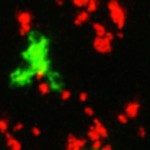Link to Pubmed [PMID] – 9593785
J. Clin. Invest. 1998 May;101(10):2290-6
Human chronic myelogenous leukemia (CML) is characterized by a translocation between chromosomes 9 and 22 that results in a BCR-ABL fusion gene coding for chimeric proteins. The junctional region of the BCR-ABLb3a2 molecule represents a potential leukemia-specific antigen which could be recognized by cytotoxic T lymphocytes (CTL). In fact, we identified a junctional nonapeptide (SSKALQRPV) which binds to HLA-A2.1 molecules. This peptide, as well as those binding to HLA-A3, -A11, and -B8 molecules (previously identified by others), elicits primary CTL responses in vitro from PBLs of both healthy donors and CML patients. Such CTL recognize HLA-matched, BCR-ABL-positive leukemic cells, implying efficient natural processing and presentation of these junctional peptides. Specific CTL were found at high frequency in 5 of 21 CML patients, suggesting that these epitopes are, to some extent, immunogenic in vivo during the course of the disease. These peptides could be useful for the development of specific immunotherapy in CML patients.

